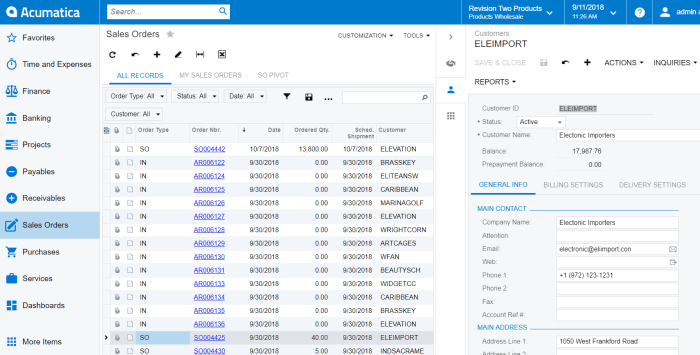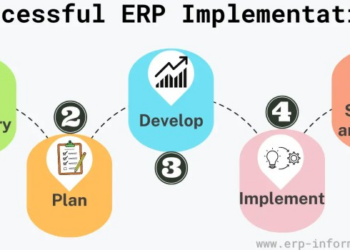Embark on a journey through the world of Acumatica software, where efficiency and innovation converge to revolutionize business operations. This guide delves into the features, implementation, customization options, integrations, and security features of Acumatica software, providing a holistic view for businesses seeking growth and optimization.
Overview of Acumatica Software
Acumatica software is a comprehensive cloud-based ERP solution designed to help businesses of all sizes manage their financials, distribution, manufacturing, and project accounting. It offers a wide range of features and functionalities that can streamline operations, improve efficiency, and drive growth.
Features and Functionalities
- Financial Management: Acumatica provides tools for general ledger, accounts payable and receivable, cash management, and financial reporting.
- Inventory Management: Users can track inventory levels, manage orders, and optimize stock levels to reduce costs.
- Project Accounting: Track project costs, manage budgets, and allocate resources efficiently.
- CRM: Acumatica offers customer relationship management tools to help businesses improve customer satisfaction and drive sales.
- Reporting and Analytics: Generate real-time reports and dashboards to gain insights into business performance.
Benefits for Businesses
- Scalability: Acumatica can grow with your business, accommodating changing needs and expanding operations.
- Flexibility: The software can be customized to fit specific business processes and workflows.
- Cost-Effectiveness: Cloud-based deployment eliminates the need for expensive hardware and IT infrastructure.
- Collaboration: Acumatica enables teams to work together seamlessly, improving communication and productivity.
Industries that Benefit
- Manufacturing: Acumatica helps manufacturers optimize production processes and manage supply chain operations.
- Distribution: Distributors can streamline order fulfillment, inventory management, and logistics with Acumatica.
- Service-Based Industries: Companies in professional services, IT, and consulting can benefit from project accounting and resource management features.
- Retail: Retailers can improve customer service, inventory control, and sales performance with Acumatica.
Implementation of Acumatica Software

Implementing Acumatica software in a business setting requires careful planning and execution to ensure a smooth transition. Below is a step-by-step guide on how to implement Acumatica software successfully, along with best practices and common challenges faced during the process.
Step-by-Step Guide for Acumatica Software Implementation
- 1. Planning Phase:
- Define goals and objectives for implementing Acumatica software.
- Identify key stakeholders and form an implementation team.
- Conduct a thorough analysis of current business processes and systems.
-
2. Configuration and Customization
- Customize Acumatica software to align with specific business requirements.
- Integrate Acumatica with existing systems and data sources.
- Train employees on using the software effectively.
-
3. Testing and Quality Assurance
- Perform thorough testing of the software to ensure functionality and reliability.
- Address any issues or bugs identified during testing.
-
4. Deployment and Training
- Roll out Acumatica software to all users in a phased approach.
- Provide comprehensive training to employees on using the software.
-
5. Monitoring and Optimization
- Monitor the performance of Acumatica software and gather feedback from users.
- Optimize the software based on feedback and evolving business needs.
Best Practices for Successful Acumatica Software Implementation
- Ensure strong leadership support and commitment throughout the implementation process.
- Engage key stakeholders and end-users early on in the process to gather feedback and address concerns.
- Follow a structured project management approach with clear timelines and milestones.
- Provide comprehensive training and support to employees to facilitate adoption of the new software.
- Regularly communicate progress updates and involve employees in the change management process.
Common Challenges and How to Overcome Them
- Lack of clear goals and objectives:
Ensure alignment between business goals and Acumatica software implementation objectives from the outset.
- Resistance to change:
Address concerns and provide adequate training and support to help employees adapt to the new software.
- Data migration issues:
Thoroughly plan and test data migration processes to avoid data loss or corruption.
- Inadequate training:
Invest in comprehensive training programs to ensure employees are proficient in using Acumatica software.
Customization Options in Acumatica Software
Acumatica software provides robust customization options that allow users to tailor the system to meet their specific business needs. Whether it's adjusting workflows, creating custom reports, or integrating with other applications, Acumatica offers a wide range of customization capabilities.
Customizing Workflows and Processes
One of the key features of Acumatica is the ability to customize workflows and processes to align with your unique business requirements. Users can easily modify existing workflows or create new ones to streamline operations and improve efficiency.
- Customizing approval processes for purchase orders, expense reports, or invoices.
- Automating notifications and reminders based on specific triggers or events.
- Configuring user permissions and roles to ensure data security and access control.
Creating Custom Reports and Dashboards
Acumatica allows users to create custom reports and dashboards to gain actionable insights into their business performance. With a user-friendly report designer tool, users can easily design, customize, and share reports tailored to their unique needs.
- Building financial reports, sales forecasts, or inventory analysis reports.
- Visualizing key performance indicators (KPIs) on interactive dashboards for real-time monitoring.
- Scheduling reports to be automatically generated and distributed to stakeholders.
Integrating with Third-Party Applications
Another advantage of Acumatica software is its ability to seamlessly integrate with other third-party applications, such as CRM systems, e-commerce platforms, or payroll software. This enables users to leverage the full potential of Acumatica by connecting it with their existing tech stack.
- Syncing customer data between Acumatica and CRM systems for a 360-degree view of customer interactions.
- Integrating with e-commerce platforms to automate order processing and inventory management.
- Connecting with payroll software to streamline payroll processing and ensure accurate financial reporting.
Integrations with Acumatica Software

Integrating third-party applications with Acumatica software can significantly enhance its functionality and streamline business operations. By connecting Acumatica with popular integrations, businesses can access a wide range of tools and services that complement and extend the capabilities of the software.
Popular Integrations for Acumatica Software
- Salesforce: Integration with Salesforce allows for seamless synchronization of customer data, leads, and opportunities between the two platforms, enabling sales and marketing teams to work more efficiently.
- Shopify: Connecting Acumatica with Shopify enables businesses to automate order processing, inventory management, and financial reporting, providing a holistic view of e-commerce operations.
- Microsoft 365: Integration with Microsoft 365 enhances communication and collaboration by syncing emails, calendar events, and documents between Acumatica and Microsoft's productivity tools.
Process of Integrating Third-Party Applications
Integrating third-party applications with Acumatica software typically involves using APIs (Application Programming Interfaces) to establish communication and data exchange between different systems. The process usually consists of the following steps:
- Identifying the integration requirements and objectives.
- Selecting the appropriate third-party application that meets the business needs.
- Configuring the integration settings and mapping data fields between Acumatica and the third-party software.
- Testing the integration to ensure data accuracy and system compatibility.
- Deploying the integration and monitoring its performance to make any necessary adjustments.
Impact of Integrations on Acumatica Software
Integrating third-party applications with Acumatica software can lead to several benefits, including:
- Improved data accuracy and consistency by eliminating manual data entry and reducing errors.
- Enhanced productivity and efficiency through automation of repetitive tasks and streamlined processes.
- Expanded functionality and capabilities by leveraging the features of integrated applications to meet specific business requirements.
- Better decision-making with access to real-time data and insights from integrated systems for informed business decisions.
Security Features in Acumatica Software

When it comes to security, Acumatica Software takes various measures to ensure data protection and privacy, safeguarding sensitive information from unauthorized access and cyber threats.
Data Encryption and Access Controls
- Acumatica employs encryption techniques to secure data both at rest and in transit, preventing unauthorized access to confidential information.
- Access controls are put in place to limit user permissions based on roles and responsibilities, reducing the risk of data breaches.
Regular Security Updates and Monitoring
- Acumatica regularly releases security updates and patches to address vulnerabilities and enhance protection against evolving cyber threats.
- Continuous monitoring of system activities helps detect any suspicious behavior or unauthorized access attempts in real-time.
Two-Factor Authentication and Audit Trails
- Two-factor authentication adds an extra layer of security by requiring users to provide a second form of verification before accessing the system.
- Audit trails provide a detailed record of user activities within the software, enabling administrators to track changes and identify potential security risks.
Best Practices for Security Maintenance
- Regularly update passwords and use strong, unique credentials to prevent unauthorized access to the system.
- Implement multi-factor authentication for enhanced security and protect sensitive data from potential breaches.
- Educate users on security best practices and conduct regular training sessions to raise awareness about data protection measures.
Final Thoughts
In conclusion, Acumatica software emerges as a dynamic solution for modern businesses, offering a versatile platform that adapts to diverse industry needs. By harnessing the full potential of Acumatica software, organizations can elevate their operations to new heights of success and efficiency.
FAQs
How can Acumatica software benefit my business?
Acumatica software offers features like real-time data insights, seamless integrations, and customizable options, empowering businesses to streamline operations and drive growth.
What industries can benefit the most from using Acumatica software?
Industries such as manufacturing, distribution, e-commerce, and professional services can greatly benefit from the functionalities and scalability of Acumatica software.
What are some best practices for implementing Acumatica software successfully?
Key practices include thorough planning, stakeholder involvement, training sessions, and post-implementation support to ensure a smooth transition and optimal utilization of the software.
How does Acumatica software ensure data security?
Acumatica software implements robust security measures such as data encryption, user access controls, and regular security updates to safeguard sensitive information and ensure data privacy.











